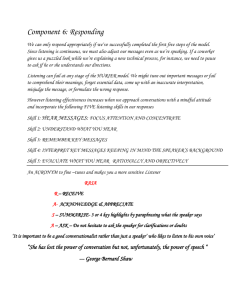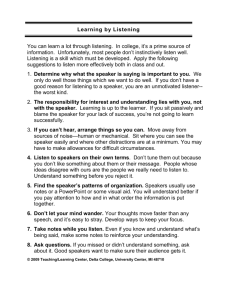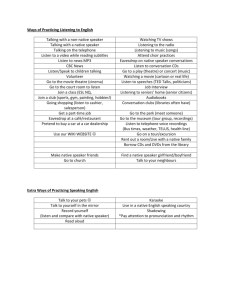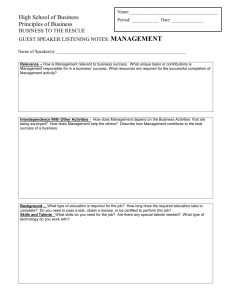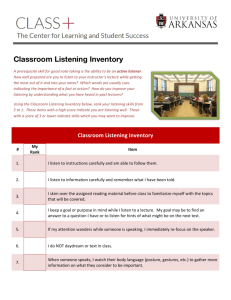Active Listening
advertisement
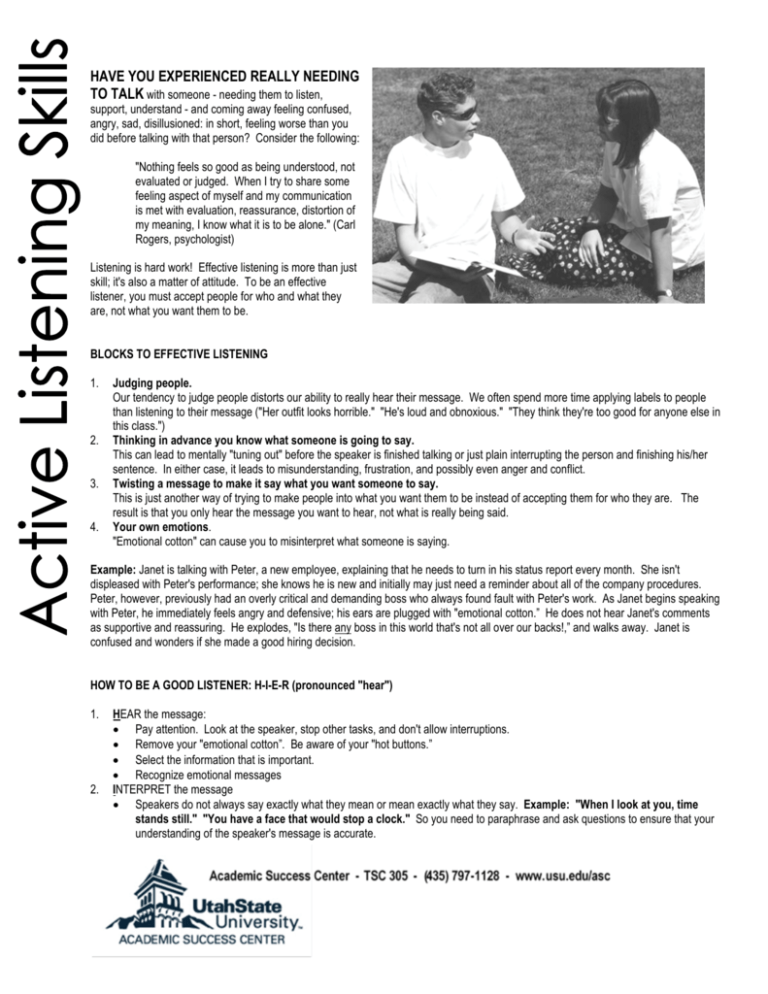
HAVE YOU EXPERIENCED REALLY NEEDING TO TALK with someone - needing them to listen, support, understand - and coming away feeling confused, angry, sad, disillusioned: in short, feeling worse than you did before talking with that person? Consider the following: "Nothing feels so good as being understood, not evaluated or judged. When I try to share some feeling aspect of myself and my communication is met with evaluation, reassurance, distortion of my meaning, I know what it is to be alone." (Carl Rogers, psychologist) Listening is hard work! Effective listening is more than just skill; it's also a matter of attitude. To be an effective listener, you must accept people for who and what they are, not what you want them to be. BLOCKS TO EFFECTIVE LISTENING 1. 2. 3. 4. Judging people. Our tendency to judge people distorts our ability to really hear their message. We often spend more time applying labels to people than listening to their message ("Her outfit looks horrible." "He's loud and obnoxious." "They think they're too good for anyone else in this class.") Thinking in advance you know what someone is going to say. This can lead to mentally "tuning out" before the speaker is finished talking or just plain interrupting the person and finishing his/her sentence. In either case, it leads to misunderstanding, frustration, and possibly even anger and conflict. Twisting a message to make it say what you want someone to say. This is just another way of trying to make people into what you want them to be instead of accepting them for who they are. The result is that you only hear the message you want to hear, not what is really being said. Your own emotions. "Emotional cotton" can cause you to misinterpret what someone is saying. Example: Janet is talking with Peter, a new employee, explaining that he needs to turn in his status report every month. She isn't displeased with Peter's performance; she knows he is new and initially may just need a reminder about all of the company procedures. Peter, however, previously had an overly critical and demanding boss who always found fault with Peter's work. As Janet begins speaking with Peter, he immediately feels angry and defensive; his ears are plugged with "emotional cotton.” He does not hear Janet's comments as supportive and reassuring. He explodes, "Is there any boss in this world that's not all over our backs!,” and walks away. Janet is confused and wonders if she made a good hiring decision. HOW TO BE A GOOD LISTENER: H-I-E-R (pronounced "hear") 1. 2. HEAR the message: • Pay attention. Look at the speaker, stop other tasks, and don't allow interruptions. • Remove your "emotional cotton”. Be aware of your "hot buttons.” • Select the information that is important. • Recognize emotional messages INTERPRET the message • Speakers do not always say exactly what they mean or mean exactly what they say. Example: "When I look at you, time stands still." "You have a face that would stop a clock." So you need to paraphrase and ask questions to ensure that your understanding of the speaker's message is accurate. Look for non-verbals that might contradict what the speaker is saying verbally. If verbals and non-verbals don't match, check it out with the speaker. Example: "I just failed my math mid-term, but it's no big deal." (smiling, but eyes moist, voice shaky, eyes downcast). EVALUATE the message Make sure that you have all of the important information before forming an opinion. Consider all available information carefully before making a final decision. Ask questions, don't jump to conclusions. RESPOND to the message Give feedback to let the speaker know what you heard and how you heard it. Responding allows you and the speaker to reach a common understanding. Example: "So, if I understand what you said, you will be meeting me at the west entrance of the Student Center at 5:15 p.m. If you aren't there, I am to park in the parking lot and go wait for you in the Hub. Is that correct?" • 3. 4. IT’S ALL IN THE EYES AND EARS OF THE BEHOLDER: How Assumptions Get Us Into Trouble Making assumptions is the process of coming to some kind of conclusion about someone or something with incomplete information. We make assumptions about people and our environment constantly. The results range from mild to severe in terms of damaged interpersonal relationships. • • • • • A person without a wedding ring isn't married (could be the person just left the ring on the sink this morning) A man with long, dirty hair, torn and unmatched clothes wandering around the streets must be homeless (could be an undercover narcotics police officer) A student who consistently gets D's and F's is unmotivated (could be the student has a learning disability or is suffering from emotional problems) A black male student at USU must be a member of the football team (most of the black male students at USU aren't athletes) A young, recently married couple is talking about where to spend Christmas. Matt and Sylvia live and go to school in Logan. Both of their families live in southern Utah. Matt is not particularly close to his family and has been independent from them for a number of years. Sylvia is extremely close to her family and has never spent a holiday away from them. Matt suggests that they stay in Logan for Christmas. As soon as Sylvia hears this, she makes an assumption that Matt is trying to pull her away from her family. She feels resentful and defensive, and an argument follows. Eventually, after a lengthy discussion, Sylvia recognizes her assumption was inaccurate. Matt had no intention of creating distance between Sylvia and her family. He made an assumption that Sylvia, like him, would want to spend their first Christmas as a married couple by themselves. It's obvious that making assumptions can severely limit your ability to communicate effectively and honestly with other people. The good news is that you can increase your awareness of how and why you make assumptions, thereby reducing or eliminating the negative effects on your relationships. Perceptual Errors Perceptions of people and events are often distorted due to the failure to consider important information. We overemphasize certain things, downplay others. This process is affected by a number of factors: age, health, sex, culture, social/sex roles, previous experiences, and even your self-concept: you tend to judge others on the basis of how you view yourself. Understanding some of the most common perceptual errors can reduce the number of assumptions you make: • • • • • We are influenced by what is most obvious, even though the most obvious factor isn't necessarily the only cause of something. We cling to first impressions, even if they are wrong. We tend to assume others are like us - think, act, feel the same. We tend to favor negative impressions over positive ones. We blame innocent victims for their misfortunes. When others have problems, we tend to assume it is due to personality defects or negative personal qualities. When we have problems, we "externalize" the blame - we tend to find outside people or things as the cause. TIPS FOR EFFECTIVE LISTENING Listen now, report later. Report what you heard to someone else later. The act of speaking out loud what you heard and processed inside your head helps you to remember the information. It also provides a way you can identify what was not totally clear about what you heard. Learn to want to listen. We must be willing to focus on others when they are speaking. Learn to develop an interest in either the person and/or the topic. Practice concentrating on the speaker’s words and feelings. Practice shutting out distractions, not allowing them to interfere with your listening. Be present. Daydreaming is a nice way to take a mental vacation. It provides a comfortable private escape. But it is one of the major barriers to effective listening. Choose to "be present." Focus on the speaker and the message. Become a "whole body" listener. To be effective listeners, we must involve our whole body. Not only are our ears tuned in, but so are our eyes, our intellect, and our bodies. Good listeners give nonverbal and verbal signs that they are listening. They sit in an attentive posture; nod in acknowledgement; make good eye contact; convey a positive, encouraging attitude; give feedback. Control your emotional "hot buttons." Words, issues, situations, and personalities can be emotional triggers for us. When these issues trigger our "hot buttons," we tend to distort, positively or negatively, the message we are hearing. We may tune out or pre-judge the message and/or the speaker. Control distractions. We must control our responses to distractions or they will control us. Distractions affect our ability to listen well because of their variety, novelty, or intensity (e.g., telephone, background noise, unfamiliar accent/vocabulary, lighting, headaches, hunger, fatigue). Adapted from Bone, Diane. The Business of Listening. Los Altos, CA: Crisp Publications, Inc., 1988 TEN STEPS FOR CONTROLLING EMOTIONAL “HOT BUTTONS” Following is a list of coping skills for preventive maintenance when a "hot button" is activated: 1. Listen attentively without interrupting. Take several deep breaths to help you control your physical reactions. 2. Make a conscious choice about your response. You can get angry, try to solve the problem, or ignore it. Trying to solve the problem is the best way to keep it from happening again. 3. Acknowledge the other person's feelings. Make it okay for them to feel the way they do. 4. Ask objective questions for clarification. Open-ended questions are useful. 5. Try to see the other person's point of view. Agree where you can and give feedback about what you are hearing. 6. Stick to the subject. Define your problem and don't let other issues interfere. 7. Be patient. Problems don't always have immediate solutions. Be patient with the other person - and yourself. 8. Express your point of view. Present your evidence without being adversarial. 9. Explain why. A reasonable explanation can often take the sting out of an emotional issue. 10. Work out a "win-win" plan. Make sure your solution is fair and workable for the people involved. Source: Bone, Diane. The Business of Listening. Los Altos, CA: Crisp Publications, Inc., 1988.


